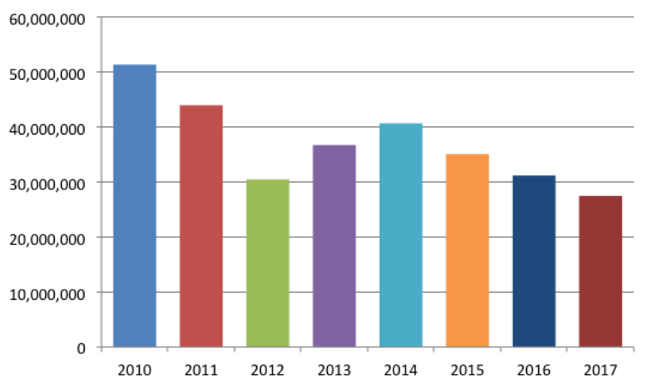

2013/07/22 Android Video Game Consoles Threaten an Established Model
Android Video Game Consoles Threaten an Established Model
Executive Summary
The Google rumor mill is at it again. According to a recent article in the Wall Street Journal, Google is planning on developing a video game console built on its Android operating system. Several Android video game consoles have been recently released on the market, notably the Ouya and NVIDIA SHIELD (shipping later this month). The article goes on to mention that Google would most likely be aiming for the lower-end (probably sub-$200) of the market with its product.
Figure 1. Worldwide Video Game Console Shipment Forecast, 2010-2017

The Ouya console costs $99, including a single controller, runs a custom version of the Android OS that will only play Ouya-approved software, and is meant to hook up to large screen televisions. The console itself has mid-level hardware, nothing near the level of say the Samsung Galaxy S3 or iPhone 5, but enough to run 1080p games that may be on par with what you might expect from a Playstation 2.
The NVIDIA SHIELD costs $299 and is a portable Android console that runs a stock version capable of running anything from the Google Play store in addition to the curated games offered by NVIDIA.
In addition to dedicated hardware, there are hundreds of millions of Android devices out there that can play games. There is not much stopping the average consumer from taking their smartphone or tablet and hooking it up to large screen television (hopefully via a powered MHL connection) and wirelessly connecting a Bluetooth controller to play games. In fact, with the advent of Wi-Fi Miracast, Apple’s Airplay, WiGig, and other standards it is more than possible to skip the wired portion of the setup and conduct everything wirelessly (power is, of course, an issue).
MRG Analysis:
Android, and by extension iOS, games only appeal to certain types of gamers. Those are primarily the casual gamer who might value gameplay over other things like graphics and gesture controls and the portable gamer who in the past might have purchased a portable console like the Nintendo DS or Playstation Vita, but finds that a smartphone or tablet suffices. Top-tier games on iOS and Android typically do not cost more than $20, and usually run between $2.99 and $10 on average. And, of course, there are dozens of top-quality free (or nearly free) games available. With graphical capabilities ever-increasing on the Android platform, the price differences between games for a traditional console like an Xbox One and these Android systems will drive a large number of consumers to the Android platform for gaming.
All is not shiny for the dedicated Android video game consoles though. The crux of the matter is the fact that more and more intelligence is getting packed into devices such as televisions, tablets, smartphones, streaming media players, and more. Right now, any of these devices has more than enough processing power and connectivity options to run video games on a big screen television similarly to a dedicated Android console. For some devices, like smartphones and tablets, it may be more cumbersome to hook up currently, but that is fast changing. And that gets us to our final point: With all this convergence going on, and the variety of streaming software (i.e. Netflix, Hulu, etc.) available in the Google Play store, the device that Google ends up building, will definitely be a convergence device, part streaming media player, part video game console.
Source: Multimedia Research Group, Inc.







